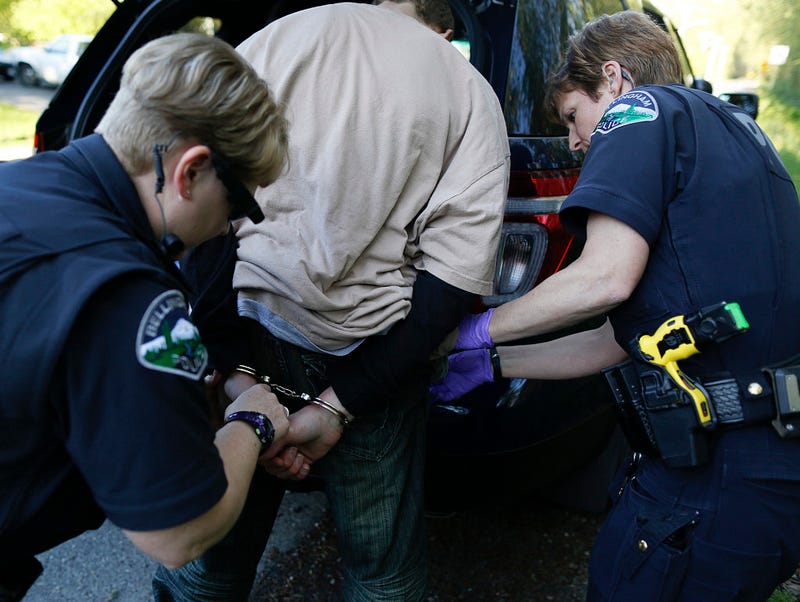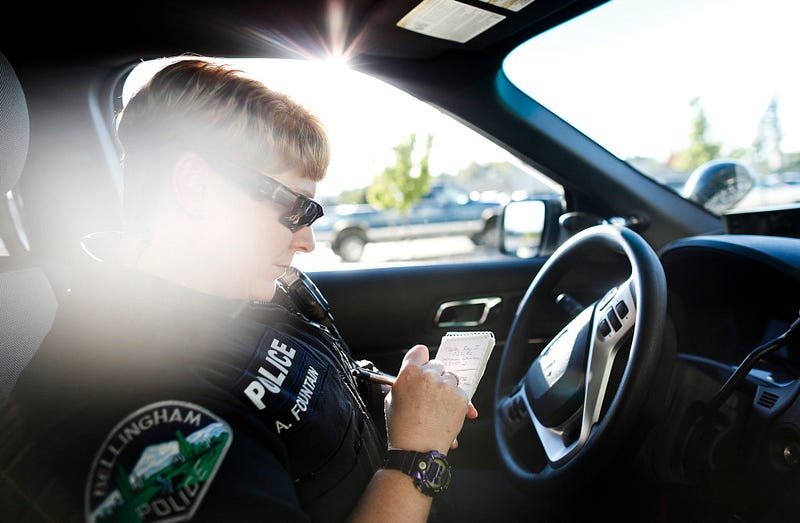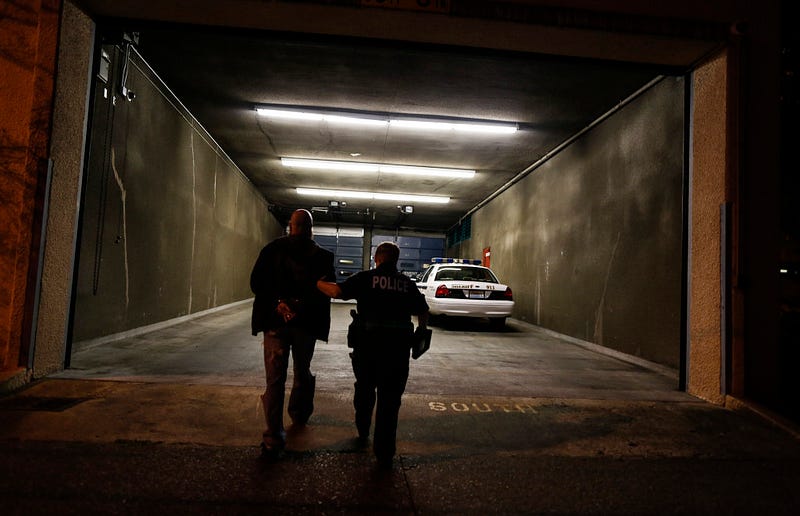A Body Behind the Lens
Bellingham police implement body cameras to improve law enforcement practices
STORY BY SHELBY ROWE | PHOTOS BY NICK DANIELSON
While responding to a welfare check on Northwest Ave, Officer Andria Fountain updates Bellingham Police Department Dispatch of the reported individual’s status and identification from a call that came in describing a person lying on the ground outside of a gas station on April 25, 2015. Bellingham Police Department officers have to choose to start recording situations with their body cameras (seen here attached to Officer Fountain’s sunglasses), however, Fountain says that she records most scenarios given constant unpredictability. Nick Danielson / Klipsun Magazine
Assess the situation.
Are they reaching for a weapon? Are they going to flee?
Are they a threat?
When a scene reaches a boiling point and use-of-force is necessary, Lt. Rick Sucee of the Bellingham Police Department says he’s the only one between the aggressor and the public.
Sucee says there’s no time for fear.
“My goal throughout my entire career is, I’m coming home at the end of the day,” he says. “So I’m not going to let some guy who’s bent on killing me get away with it. I think officers have to have that kind of mindset, that they’re coming home at the end of the day.”
Sucee is a Bellingham native and has been part of the Bellingham police force for more than 40 years.
His raspy voice and kind smile exude the warmth of someone who loves his community, but while in uniform, he commands noticeable attention in public.
The police force has evolved over the years, Sucee says.

The Bellingham department began using body cameras in spring 2014, and while only 35 of the 115 officers are wearing the cameras, the department is in favor of the technology. Since the program started, more officers are asking for cameras — at least 10 more officers will have cameras by August 2015.
Lt. Mike Johnston is program manager for the body-worn cameras and was among those who implement them to showcase how well the officers handle themselves. He had heard positive feedback about other departments who used the cameras.
If a use-of-force complaint comes in, there is no dispute over what happened and the department can view the footage, Johnston says. Anyone can video record an incident on the street, and now the police have thousands of their own tapes.
“Now, if [an officer] does something wrong then [the tapes] are going to show that too,” Sucee says.
William Farrar, police chief of the Rialto Police Department in California, published a one-year study in 2013 that found a 50 percent reduction in use-of-force complaints after the department started using body cameras.
One explanation is that humans are more likely to cooperate with rules when they know they are being observed, so people become more prone to socially acceptable behavior, according to the report.
The physical presence of other people often deters bad behavior and the cameras act like that second pair of eyes.
Johnston agrees that the cameras can stop officers from potentially reacting harshly to a situation, and while the department rarely has use-of-force complaints, the cameras could stop an officer from cussing back at a subject if the person is verbally volatile first.
In Bellingham, only the newly hired officers are required to wear the body cameras. The department wants all the police officers to wear them, but officers already on the force were given the option to wear one or not, Johnston says.
Some resistance comes from officers who don’t want their commanding officers scrutinizing every second of their shift, thumbing through the footage and nit-picking their every action, Sucee says.
But management only reviews the footage if there is a citizen complaint, and from there the commanding officer decides if discipline is necessary.
Most of the complaints that come in are people that were drinking the night before and accuse the officer of being unreasonably rough or rude, Sucee says.

A SNAPSHOT OF THE PAST
Rewind to the 1970s and Bellingham was like the Wild West.
Brawls broke out at the Salty Pelican — a bar that is no longer in existence — and drunken fights erupted on Holly Street.
Back then, people seemed to have more respect for police officers and they could arrest someone in the middle of a drunken crowd without being harassed, Sucee says.
Even then it was typical to get into three or four physical fights a week with rowdy citizens while working patrol on the night shift.
The community culture has changed throughout the years, and while Sucee says he isn’t sure why the fighting has died down, police use-of-force is highly publicized.
“I think use-of-force is reported more,” he says. “I think with the invention of cell-phone cameras it has come to the forefront. I’m not saying what they’ve filmed is right or wrong, but anyone who takes the picture, if they don’t have the full story, they can put a spin on it.”
Peter Scharf, a criminology professor at Louisiana State University and former Seattle resident, agrees that use-of-force and deadly force numbers are lower than they were several decades ago, but now, everyone is a walking cameraman and the media may be memorializing deadly-force cases.
MINIMUM FORCE

America has moved away from tight-knit communities and toward a phenomenon where we are all strangers, which can create mistrust between citizens and the local police officers, Scharf says.
The key is noticing the signs when a situation escalates and trying to de-escalate it before it turns to deadly force.
A situation may look like excessive force if it’s one person against five police officers, but the main goal is minimum force and it’s safer for both parties if multiple officers can subdue the subject, Sucee says.
A one-on-one fight often results in more injuries, he says.
Sucee says he tries de-escalation tactics to calm the situation by talking to the subject and giving them space. If an arrest is necessary, it’s better for the officer to explain what they are doing instead of roughly handcuffing them, he says.
But sometimes it intensifies and a defensive reaction is necessary.

Police training used to mirror military basic training, but that approach died down by the time Sucee went through the academy 42 years ago.
Now there is more stress on community relations, but also more prominence on weapons and defensive training, he says.
“I think there is more emphasis now on reacting quickly to perceived threats and reacting in a way that will stop the threat,” Sucee says. “That’s not the way I was trained, but is that going to cause more lethal situations or people who get injured? I don’t know.”
The issue may not be with militarized training, but with a person whose personality is to snap under a stressful situation, he says.
“I couldn’t imagine a feeling of shooting someone or injuring them,” he says. “It doesn’t appeal to me, but if I had to, like I said earlier, I’m going home at the end of the day and I’ll do what I have to.”*
*Correction made to quote 8/15 for quality purposes.
